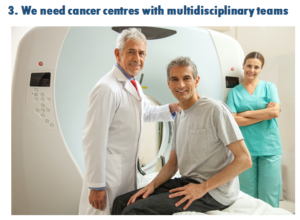Why do surgery or radiation treatments affect mens’ continence. The incontinence is due to injury or damage to sphincter muscles and other tissues that control the urine flows from the bladder to the penis. In many cases, the initial incontinence after treatment can decline in the year after treatment but as the survey results indicate full recovery is not always obtained.
Looking at incontinence, overall, 61% of the men surveyed said they lacked some urinary control (frequent dripping or no control) and 17% judged it to be a big or moderate problem. Those who have had a prostatectomy report less urinary control than those who have had radiotherapy or other treatments, and this results in a lower quality of life related to urinary symptoms. Comparing the surgery figure with active surveillance suggests that surgery doubles the rate of incontinence (see U2 below).
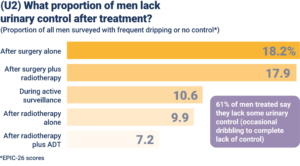
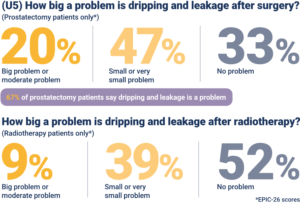
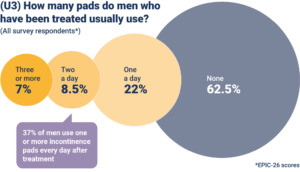
What does this mean for patients in practical terms? The survey asked men how many incontinence pads they use each day, and across all the survey respondents over a third use one or more pads a day. Of respondents who had had a prostatectomy, half were using pads. To put this into context, a 2017 study of men with roughly the same age profile who had NOT been treated for prostate cancer found that around 5% wear pads (PMID: 28168601). So there is clearly a significant effect here.

The first message is that active surveillance should be always be considered, if it can be applied safely, because overall it best protects quality of life. Certainly, in terms of incontinence and sexual function, the contrast between this and other approaches is clear.

The second take-home message is that early detection of prostate cancer is of the utmost importance. The more advanced the prostate cancer at diagnosis, the worse the effects of treatment on quality of life. The graph here shows that, looking at many factors together – discomfort, tiredness, insomnia and mental health – all of these are experienced more severely with treatments associated with more advanced prostate cancer.
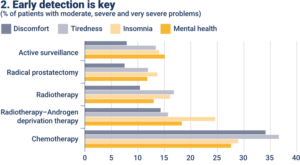
And the third message we can take from all the data from the EUPROMS study is that high quality treatment and support are essential. The EUPROMS results show the severe effects that can come with treatment for prostate cancer. Men need all the expertise and experience they can get during treatment and after, with information and support at each stage of the journey. Every man with prostate cancer should be treated in a cancer centre with multidisciplinary teams.
